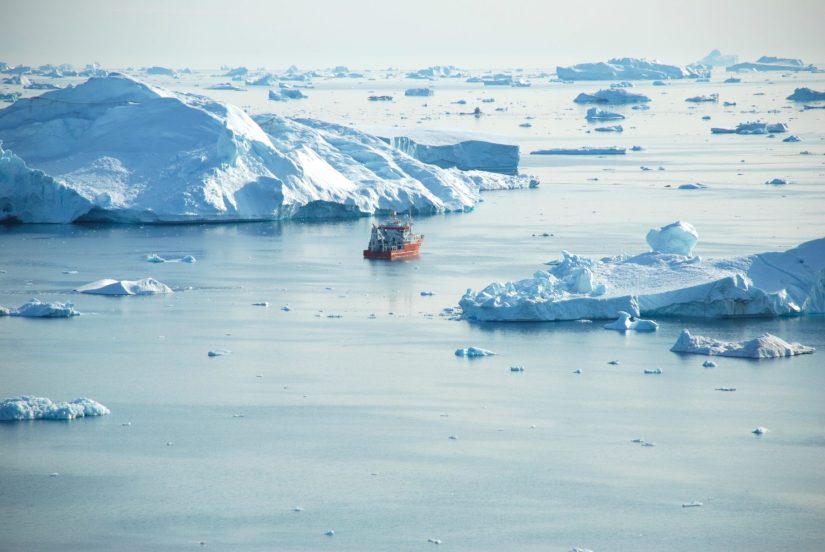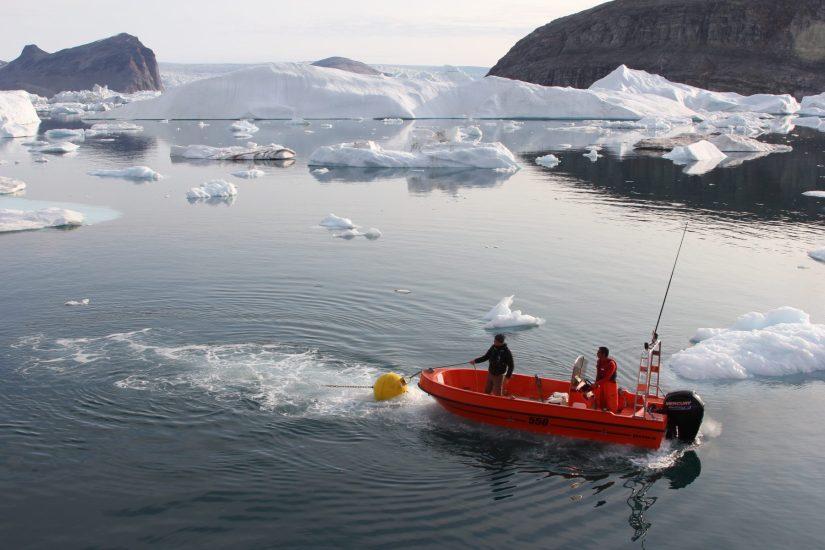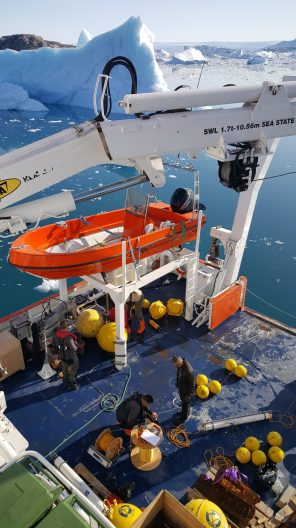Listening closely: Using acoustics to study Greenland’s marine mammals
Recently completing her PhD focused on marine mammals in Greenland, Marie Zahn’s work in the Arctic provides a deeper look into two species: narwhals and belugas.
Conducting her research at the School of Aquatic and Fishery Sciences (SAFS) as a member of the Laidre Lab, Marie explored the marine habitat and sounds produced by narwhals and belugas using oceanographic and acoustic data collected from West Greenland.

Belugas and narwhals make a variety of sounds, such as whistles and echolocation clicks, all used for communicative and sensory purposes. Scientists use underwater recordings to identify when marine mammal species are present to learn about their distribution and behavior. But for the beluga and narwhal it can be difficult to distinguish between their sounds when they’re present in the same areas. One of the main questions tackled by Marie in her dissertation was: can echolocation clicks be used to distinguish between narwhals and belugas in acoustic recordings?
The short answer is yes. To tackle this question, Marie used multiple acoustic datasets from West Greenland, including recordings from hydrophones attached to moorings on the seafloor left for years at a time. These long-term datasets are valuable recordings of the animals present in the Arctic waters around Greenland. But Marie had to figure out how to differentiate between beluga and narwhal echolocation in order to determine what species were present.
Echolocation clicks are high-frequency signals used by toothed whales for navigation and identifying their physical surroundings – when sound waves bounce off an object, they return to the whale and provide information on what the object is. Most of the energy produced by narwhals and belugas is in a pitch above the human hearing range, so they are inaudible to us, but scientists record and create plots to show how much energy exists at different frequency bands. They can then use this data to calculate different characteristics of the sound based on how much energy exists at certain frequencies. With this information they can tell apart the two species, a process known as acoustic classification.

So how do belugas and narwhals sound different? Marie’s research has shown that belugas produce higher frequency echolocation signals – around 30 kHz and higher – whereas narwhal clicks have a clear lower limit of energy and drop off around 20 kHz. She also demonstrated that the ratio of total energy within specific frequency bands, called one-third octave levels, is a robust metric for beluga and narwhal acoustic classification. These one-third octave ratios may be useful for accurately identifying toothed whale species in other parts of the world. Insights generated from passive acoustics like those in Marie’s doctoral work allow scientists to differentiate between the species present in Greenlandic waters.
Research such as this is important as the Arctic is warming at rates 3 times faster than the rest of the globe, with ecosystems and habitats changing dramatically in short periods of time. Each sub-population of belugas and narwhals face different threats at varying magnitudes, and understanding the behavior and habitat use of these populations in the Arctic is important.
Subpopulations of belugas and narwhals in West Greenland are generally still understudied but face a number of growing risks. Climate change, habitat loss, and increases in vessel traffic are just some of these threats. Passive acoustics is an important tool to deliver deeper insight into how these species are being impacted by habitat change and how they might be changing their behavior as a result. For instance, belugas and narwhals actively communicate with their pods as they migrate. This same migration route overlaps with vessel traffic through the Northwest Passage in West Greenland that leads to Alaska. It is known that vessels, such as big tankers, can obscure whale communication and disturb animals. Passive acoustic monitoring that measures underwater noise levels and species presence can provide data on long-term changes in beluga and narwhal migration and behavior.

Passive acoustics gives researchers the where, when, and what animals are present in a particular location. Marie went a step further in the last chapter of her dissertation and used oceanographic data, like temperature and salinity, to study the characteristics of narwhal and beluga habitat.
Focusing on coastal waters near glacier fronts in Northwest Greenland that narwhals return to every summer, she looked deeper into the seasonality of ocean conditions. Narwhals are known to go right up to the glacier face and hang out in the bays and fjords, but researchers haven’t known why. Is it because of feeding opportunities or protection for rearing calves? Are there specific features of these glaciers and fjords that attract them there?
With two years of continuous temperature and salinity measurements, Marie found a clear seasonal pattern in ocean properties near glaciers in Northwest Greenland. As temperatures warm during summer, glacier ice and sea ice melt and cold, fresh water is released along the coast.

The Greenland Ice Sheet melts every year during the summer, with large volumes of meltwater draining through various pathways to the coastline and being discharged from the base of the glaciers underwater. These large meltwater plumes create an interesting biological event that acts as an upwelling system. The buoyant meltwater which is less dense than the deep water its surrounded by moves straight up the surface, mixing water and bringing nutrients up. This enhances biological productivity in these areas and could be why narwhals return to these locations year after year.
Studies have shown narwhals prefer habitats with colder temperatures. Working on a separate paper led by Kristin Laidre that links the acoustic presence of narwhals with other environmental variables such as temperature and salinity, Marie shares that it may be the cold, fresh meltwater released from summer ice melt and upwelling plumes that attract narwhals.
By studying temperature and salinity over time, researchers can understand the major processes occurring and how it impacts the biology and ecology of the system, painting a better picture of what’s important in this habitat.